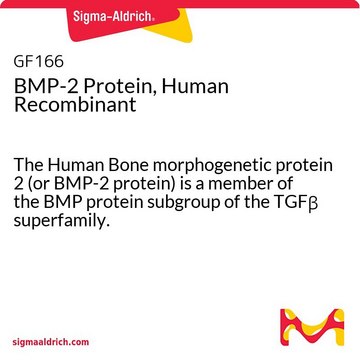B1814
BMP2, human
Carrier Free, ≥98% (SDS-PAGE), recombinant, expressed in E. coli, lyophilized powder, suitable for cell culture
Sinonimo/i:
BMP-2
About This Item
Prodotti consigliati
Nome del prodotto
Bone Morphogenetic Protein 2 human, Carrier Free, ≥98% (SDS-PAGE), recombinant, expressed in E. coli, lyophilized powder, suitable for cell culture
Origine biologica
human
Livello qualitativo
Ricombinante
expressed in E. coli
Saggio
≥98% (SDS-PAGE)
Stato
lyophilized powder
PM
26 kDa
Confezionamento
pkg of 10 μg
Condizioni di stoccaggio
avoid repeated freeze/thaw cycles (Do not store in a frost-free freezer.)
tecniche
cell culture | mammalian: suitable
Impurezze
Endotoxin, tested
Colore
white
Solubilità
water: soluble 0.100 mL, clear, colorless
N° accesso UniProt
Temperatura di conservazione
−20°C
Informazioni sul gene
human ... BMP2(650)
Cerchi prodotti simili? Visita Guida al confronto tra prodotti
Azioni biochim/fisiol
Stato fisico
Risultati analitici
Codice della classe di stoccaggio
11 - Combustible Solids
Classe di pericolosità dell'acqua (WGK)
WGK 3
Punto d’infiammabilità (°F)
104.0 °F - closed cup
Punto d’infiammabilità (°C)
40.0 °C - closed cup
Scegli una delle versioni più recenti:
Certificati d'analisi (COA)
Non trovi la versione di tuo interesse?
Se hai bisogno di una versione specifica, puoi cercare il certificato tramite il numero di lotto.
Possiedi già questo prodotto?
I documenti relativi ai prodotti acquistati recentemente sono disponibili nell’Archivio dei documenti.
Il team dei nostri ricercatori vanta grande esperienza in tutte le aree della ricerca quali Life Science, scienza dei materiali, sintesi chimica, cromatografia, discipline analitiche, ecc..
Contatta l'Assistenza Tecnica.



